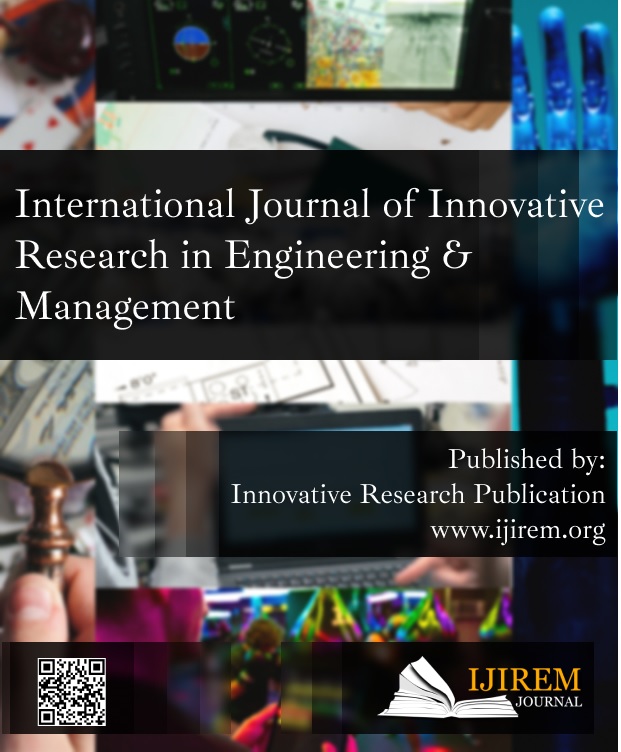A Power Generation Study Using a Hybrid Model of Solar and Wind Energy
Keywords:
Carbon footprint, Outage, Hybrid Renewable Energy, Battery Bank, Standalone, PVAbstract
With a large number of cities and villages, India is the second highest populated country in the world. In India, villages still house a sizable percentage of the people. To better their socioeconomic situation, small cottage businesses that may employ local residents should be developed. The industries included in the programme are small cottage businesses that operate during the day and close at night. These businesses need a steady supply of electricity. However, due to its geographic constraints, the area has seen a significant loss of supply and has frequently finding electricity inadequate to run the equipment. As a result, industry expansion would be impeded, and local residents' development would be affected. Renewable energy, on the other hand, may be produced and utilized on-site, enhancing supply reliability. They have a cheap operating cost because they are renewable in nature. However, because renewable energy output is entirely dependent on weather conditions, a battery bank must be used as a backup.. This backdrop describes a way for combining solar PV with wind energy. The system considers integrating solar PV and wind energy to satisfy demand because they compliment each other in nature. The software may be used independently. The system runs several permutations of the model to find the most optimum model capable of providing consistent, acceptable quality, and cost-competitive electricity. The strategy also researches and analyses the degree of renewable penetration to minimize carbon footprint, investigates combinations to reduce capital investment, and focuses on decreasing the levelized cost of energy.
Downloads
References
IEA, International energy annual 2004. Energy Information Administration; 2006
Raj A.K., Srivastava A.P., Dwivedi M. 2013 “Power plant engineering”, ISBN (13) : 978-81- 224-2333-4, New Age International (P) Ltd., publisher, New Delhi, India
Akella AK, Saini RP, SharmaMP. Social, economical and environmental impacts of renewable energy systems. Renewable Energy 2009;34:390–6
Ma T, Yang H., Lu L., &Peng J., (2015). Pumped storage-based standalone photovoltaic power generation system: Modeling and techno-economic optimization. Applied Energy, 137, 649-659.
O'Shaughnessya Eric, Cutlera Dylan , Ardania Kristen, Margolisa Robert, (2018) Solar plus: Optimization of distributed solar PV through battery storage and dispatchable load in residential buildings . Applied Energy, 213, 11-21
[last accessed 10.03 2021
Chen H, Cong TN, Yang W, Tan C, Li Y, Ding Y. Progress in electrical energy storage system: a critical review. Prog Nat Sci 2009;19:291e312.
Kocak K. Practical ways of evaluating wind speed persistence. Energy 2008;33: 65–70
Sahin AZ, Aksakal A. Wind power energy potential at the Northeastern region of Saudi Arabia. Renew Energ 1998;14:435–40
Liu LQ,Wang ZX, Zhang HG, Xue YC. Solar energy development in China – a review. Renewable and Sustainable Energy Reviews 2010; 14:301 – 11.
Annual report 2004 of Ministry of Non Conventional Energy Sources (MNES), Govt. of India, www.mnes.nic.in
Chaurey A., &Kandpal T. C. (2010). A techno economic comparison of rural electrification based on solar home systems and PV microgrids. Energy Policy, 38(6), 3118-3129 Kristinsson, K., & Rao, R. (2008). Interactive Learning or Technology Transfer as a Way to Catch-Up. Analysing the Wind Energy Industry in Denmark and India. Industry & Innovation, 15(3), 297–
Kristinsson, K., & Rao, R. (2008). Interactive Learning or Technology Transfer as a Way to Catch-Up. Analysing the Wind Energy Industry in Denmark and India. Industry & Innovation, 15(3), 297–320.
Ashok, S. (2007). Optimised model for community based hybrid energy system. Renewable Energy, 32(7), 1155–1164
Analysis of photovoltaic system energy performance evaluation method- National Renewable Energy Laboratary USA
International Electro technical Commission, Photovoltaic system performance monitoring – guidelines for measurement data exchange and analysis International Standard IEC61724 Ed
Arribas L., Cano L., Cruz I., Mata M., &Llobet E. (2010). PV–wind hybrid system performance: A new approach and a case study. Renewable energy 35(1), 128-137.
IS/IEC 61724:1988, Indian standard Photovoltaic system performance monitoring-guidelines for measurement, data exchange and analysis
Bhattacharjee S., & Acharya S. (2015). PV–wind hybrid power option for a low wind topography. Energy Conversion and Management, 89, 942-954
Ma T, Yang H, Lu L. A feasibility study of a stand alone hybrid solar–wind– battery system for a remote island. Appl Energy 2014; 121:149–58.
Ma T., Yang H., Lu L., &Peng J. (2015). Pumped storage-based standalone photovoltaic power generation system: Modeling and techno-economic optimization. Applied Energy, 137, 649-659.
